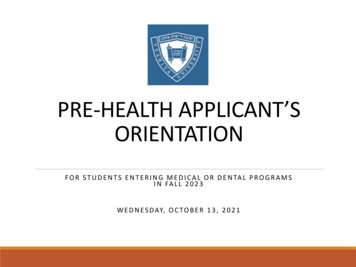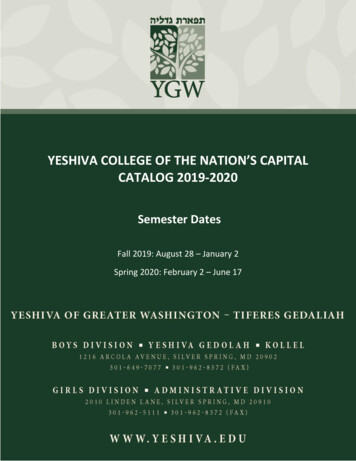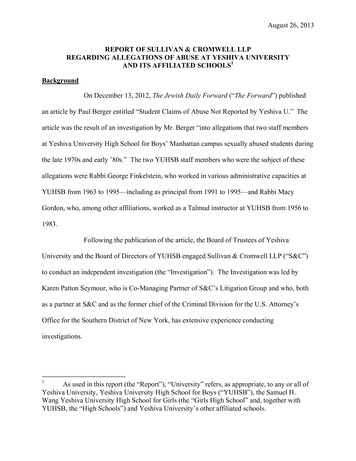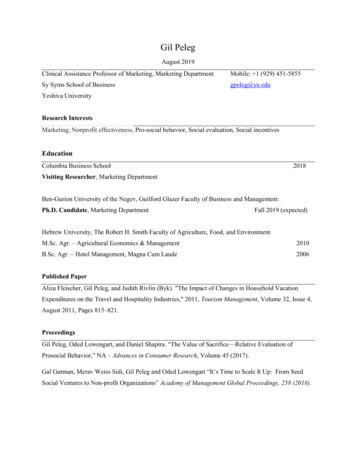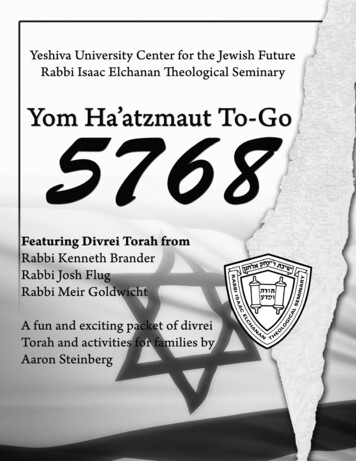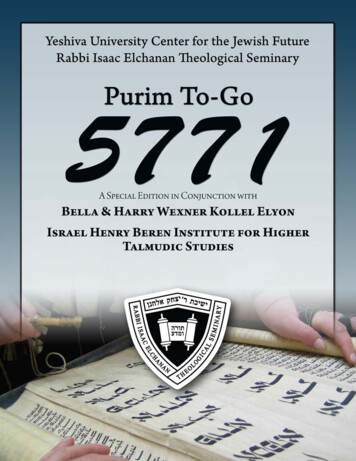
Transcription
1YESHIVA UNIVERSITY PURIM TO-GO ADAR 5771
Adar 5771Dear Friends,It is my sincere hope that the Torah found in this virtual ספר may serve to enhance your פורים (Purim) and your ( לימוד study).We have designed this project not only for the individual, studying alone, but perhaps evenmore for a ( חברותא a pair studying together) that wish to work through the study mattertogether, or a group engaged in facilitated study.With this material, we invite you to join our Beit Midrash, wherever you may be, להגדיל תורה ( ולהאדירה to enjoy the splendor of Torah) and to engage in discussing issues that touch on amost contemporary matter, and are rooted in the timeless arguments of our great sages fromthroughout the generations.Bivracha,Rabbi Kenneth BranderThe David Mitzner Dean, Yeshiva UniversityCenter for the Jewish FutureRichard M Joel, President, Yeshiva UniversityRabbi Kenneth Brander, The David Mitzner Dean, Center for the Jewish FutureRabbi Robert Shur, General EditorRabbi Michael Dubitsky, EditorCopyright 2011All rights reserved by Yeshiva UniversityYeshiva University Center for the Jewish Future500 West 185th Street, Suite 413, New York, NY 10033office@yutorah.org 212.960.5400 x 5313This publication contains words of Torah. Please treat it with appropriate respect.For sponsorship opportunities, please contact Andrew Goldsmith at 212.960.5852 or agoldsm1@yu.edu.2YESHIVA UNIVERSITY PURIM TO-GO ADAR 5771
Table of ContentsPurim 2011/5771“Ad De’lo Yada” – An Elucidation of the Notion ofIntoxication on PurimRabbi Yona Reiss . . . . . . . . . . . . . . . . . . . . . . . . . . . . . . . . . . . . . . . . . . . . . . . Page 5When is a Bar Mitzvah in a Leap Year?Rabbi Mordechai Willig. . . . . . . . . . . . . . . . . . . . . . . . . . . . . . . . . . . . . . . . Page 9Seudat PurimRabbi Simon Basalely. . . . . . . . . . . . . . . . . . . . . . . . . . . . . . . . . . . . . . . . . . . Page 12A Life of GivingRabbi Reuven Brand . . . . . . . . . . . . . . . . . . . . . . . . . . . . . . . . . . . . . . . . . . . Page 17The Halachah of History:Ancient Cities and the Date of PurimRabbi Jonathan Cohen. . . . . . . . . . . . . . . . . . . . . . . . . . . . . . . . . . . . . . . . . . Page 21Why Don't We Recite Hallel on Purim?Rabbi Joshua Flug . . . . . . . . . . . . . . . . . . . . . . . . . . . . . . . . . . . . . . . . . . . . . Page 35The Meaning of Myrtles: Understanding Esther’s OtherNameRabbi David Hellman. . . . . . . . . . . . . . . . . . . . . . . . . . . . . . . . . . . . . . . . . . . Page 40The Man-Made HolidayRabbi Aaron Kraft . . . . . . . . . . . . . . . . . . . . . . . . . . . . . . . . . . . . . . . . . . . . . Page 46Making Scents of PurimRabbi Yoni Levin . . . . . . . . . . . . . . . . . . . . . . . . . . . . . . . . . . . . . . . . . . . . . . Page 51Purim: Out of ControlRabbi Moti Neuburger. . . . . . . . . . . . . . . . . . . . . . . . . . . . . . . . . . . . . . . . . Page 553YESHIVA UNIVERSITY PURIM TO-GO ADAR 5771
A Tale of Two Cities?Shushan Purim in Modern-day YerushalayimRabbi Etan Schnall . . . . . . . . . . . . . . . . . . . . . . . . . . . . . . . . . . . . . . . . . . . . . Page 64Purim: The Other Day of RestRabbi Tzvi Sinensky . . . . . . . . . . . . . . . . . . . . . . . . . . . . . . . . . . . . . . . . . . . . Page 75The Machatzit HaShekel and Selfless GivingRabbi Moshe Stavsky . . . . . . . . . . . . . . . . . . . . . . . . . . . . . . . . . . . . . . . . . . . Page 82Hester Panim: Between Exile and RedemptionRabbi Yehuda Turetsky . . . . . . . . . . . . . . . . . . . . . . . . . . . . . . . . . . . . . . . . . Page 864YESHIVA UNIVERSITY PURIM TO-GO ADAR 5771
“Ad De’lo Yada”An Elucidation of theObligation ofIntoxication on PurimRabbi Yona ReissMax and Marion Grill Dean, RIETSOne of the most unusual laws of Purim relates to the apparent requirement to becomeintoxicated during the Purim festival:Rava said: a man is obligated to become intoxicated on Purimuntil he does not know the difference between “cursed is Haman”and “blessed is Mordechai”Megilla 7b אמר רבא מיחייב איניש לבסומי בפוריא עד דלא ידע בין ארור המן לברוך מרדכי : מגילה ז This halakha has engendered tremendous interest and discussion as it seems to represent theonly time that there appears to be an actual requirement for drunkenness in Jewish law. Whilelater authorities explain that outright drunkenness is not an imperative, and a little drinking anddrowsiness certainly suffices (see Rema, 695:2, and Biur Halakha ad loc., s.v. “Ad De’lo Yada”),the requirement not to be able to differentiate between Haman’s curse and Mordechai’s blessingremains puzzling.There are a number of different explanations given to explain this precept. For example, someauthorities (see Magen Avrohom, 695:3) explain that the Gematria (numerical value) of thephrases ארור המן and ברוך מרדכי are identical (502). Thus, one should drink until he issufficiently groggy to become unable to render this calculation. The obvious question, however,is that if the obligation requires that a person not appreciate that the numerical value is the samebut rather think that the calculations are different, the wording of the halakhic obligation shouldbe – עד דידע בין ארור המן לברוך מרדכי that one should drink until he mistakenly does discern adifference (at least in Gematria) between the two phrases.5YESHIVA UNIVERSITY PURIM TO-GO ADAR 5771
Perhaps we can offer a few alternative approaches. One possible approach is based on theMishna in Berachos which states that:Just as one is obligated to make a blessing of “Hatov Ve’HaMeitiv” uponhappy tidings, so too one is obligated to make a blessing of “DayanHaEmes” upon bad tidingsMishna Berachos 54a (as explicated by the Gemora in Berachos 60b) חייב אדם לברך על הרעה כשם שמברך על הטובה . ברכות נד The ascendancy of Haman, and his attempt to exterminate the Jewish people, certainlycomprised bad tidings. By contrast, Mordechai’s resistance and his successful efforts to thwartHaman constituted good tidings for the Jewish people. The principle evoked by the Mishna inBerachos is that both bad tidings and good tidings are worthy of making a blessing since weappreciate that both what we perceive as bad and as good emanate from Hashem, and כל דעביד – רחמנא לטב עביד all that is done by Hashem is for the best (Berachos 60b).Accordingly, the Gemora in Pesachim (50a) notes that in the World to Come, there will be noseparate benediction upon bad tidings, and that the appreciation of the goodness of Hashem inall matters will be so intensely appreciated that the happy blessing of “HaTov Ve’HaMeitiv” willbe recited on all tidings (see Maharsha ad loc.).Since the holiday of Purim is a holiday that celebrates the victory of the Jewish people during atime of exile that helped pave the way to the completion of the rebuilding of the Holy Temple inJerusalem, and, as the Rambam writes (Hilkhot Megilla 2:18), the observance of Purim will bethe only event of past deliverance that shall be remembered for all eternity, it is appropriateduring the Purim celebration to bring ourselves into the state of euphoria that we will experienceduring the eschatological age at which time we will recognize that even – ארור המן that whichappears to be a curse – is also something to appreciate in the same manner as – ברוך מרדכי thatwhich is more obviously a blessing. Accordingly, we drink on Purim עד דלא ידע בין ארור המן – לברוך מרדכי until we are able to experience this ideal sense of appreciation.A second approach can be traced to a verse at the beginning of Megillat Esther (1:8) whichdescribes the great feast prepared by King Achashverosh for his subjects in Shushan, the capitalcity:And the drinking was according to the law, without coercion; for so theKing had ordered all of the officers of his house that they should doaccording to every man’s pleasuretranslation from Art Scroll והשתיה כדת אין אנס כי כן יסד המלך על כל רב ביתו לעשות כרצון איש ואיש The Gemora (Megilla 12a) comments: לעשות כרצון : אמר רבא - לעשות כרצון איש ואיש איש - המן , דכתיב איש יהודי - מרדכי , מרדכי והמן צר ואויב Rava said – the words איש ואיש connote that thedrinking was served in a manner to satisfy thepleasure of both Mordechai and Haman.6YESHIVA UNIVERSITY PURIM TO-GO ADAR 5771
Thus, Rava who articulated the rule that one must drink on Purim until he cannot discern thedifference between ארור המן and ברוך מרדכי also interpreted the verse in Megillat Estherconcerning the non-coercion with respect to drinking at the feast of Achashverosh as pertainingjointly to these same two individuals.The author of Yeynah Shel Torah quotes an explanation that Mordechai and Haman both werepleased, for separate reasons, that the drinking was not coerced. Mordechai was pleased becausethe Jews were not forced to partake of the wine from the feast of Achashverosh. Haman, on theother hand, was pleased because he knew that if the Jews did partake of the wine of their ownfree will, they would be subject to Divine punishment.Perhaps this Midrash, which equates Mordechai and Haman in terms of their shared desire thatthe drinking of the wine at the feast of Achashverosh not be coerced, constitutes the ultimatesource of the halakha that one should become intoxicated until he can no longer differentiatebetween ארור המן and ברוך מרדכי . Through the institution of the observance of חייב איניש לבסומי – בפוריא of the obligation to drink wine in order to perform a mitzvah, the ארור המן becomesidentical with the ברוך מרדכי . In other words, the very act of intoxication which would havefulfilled the evil plans of the accursed Haman during the feast of Achashverosh, becomestransformed on Purim into a mitzvah worthy of the blessing of Mordechai!We may suggest one more variation of this explanation. The Hagahot Maimoniyot in hiscomments to the Rambam on Hilkhot Megilla (2:15), makes the observation that although theRambam writes that there is an obligation to drink wine and become drunk during the Purimfeast, this is not an absolute obligation but simply a מצוה בעלמא ולא לעכב - a fulfillment of amitzvah that is non-mandatory in nature. Based on this understanding, the identification of ארור המן with ברוך מרדכי becomes even more pronounced. At the original feast of Achashverosh,Haman’s objective was that the Jews would choose to drink, while Mordechai’s objective wasthat the Jews would choose not to drink. In the current mitzvah celebration of our own Purimfeast, the two options remain available – both to drink and not to drink, according to theHagahot Maimoniyot. Thus, עד דלא ידע בין ארור המן לברוך מרדכי could be interpreted asindicating that the degree of intoxication remains – אין אנס non compulsory, in the same waythat the ארור המן and ברוך מרדכי were identical in endorsing the notion of non-compulsorydrinking during the feast of Achashverosh.A final insight emerges from the Gemora in Gittin (57b): מבני בניו של המן למדו תורה בבני ברק .Haman had descendants who converted to Judaism and learned Torah in B’nei Brak. Theultimate victory of Purim was manifested through כז( – קיימו : קימו וקבלו היהודים )מגילת אסתר ט (. מה שקבלו כבר )שבת פח , the re-affirmation by the Jewish people of the acceptance of TorahU’Mitzvot. Perhaps the greatest capstone of this achievement was that the accursed Haman – ארור המן - who had sought to erase the Torah through the destruction of the Jewish people, haddescendants who joined the ranks of ברוך מרדכי in perpetuating Torah. Fittingly, Purimpresents us with a special opportunity – לבסומי ביינה של תורה to share the fragrance of Torahlearning at Yeshivat Rabbeinu Yitzchok Elchanan (RIETS) and the high level of Torah eruditionof the outstanding fellows in the Kollel Elyon. Under the supervision of the Roshei Kollel, Rabbi7YESHIVA UNIVERSITY PURIM TO-GO ADAR 5771
Mordechai Willig shlit”a and Rabbi Michael Rosensweig shlit”a, and the continued mentorshipof Rabbi Zevulun Charlop shlit”a, the Kollel Elyon at RIETS embodies the supreme value oflearning Torah Lishmah that constitutes the cornerstone of Yeshiva University. Our ability toimbibe Torah freely is a tribute to the heroic leadership of President Richard M. Joel shlit”a andRosh HaYeshiva Rabbi Dr. Norman Lamm shlit”a. We are proud and indeed intoxicated withjoy to present this volume of Torah Insights from our Kollel Elyon to the broader Jewishcommunity.8YESHIVA UNIVERSITY PURIM TO-GO ADAR 5771
When is a Bar Mitzvahin a Leap Year?Rabbi Mordechai WilligRosh Yeshiva, RIETSRosh Kollel, Wexner Kollel ElyonThe Jewish calendar has 12 months. In a leap year, there are 13 months. Each month has either29 or 30 days, and the first month is the month of Nissan (Shemos 12:2.) If a boy is born on the29th of Cheshvan (in a year when Cheshvan has 29 days) he becomes a bar mitzvah on hisbirthday even if that year Cheshvan has 30 days. The fact that it isn’t the last day of the month ishalachically irrelevant.Born in a Regular Year, Bar Mitzvah in a Leap YearWhat if a boy is born in the 12th month, Adar, in a year that has 12 months, and becomes a barmitzvah in a year that has 13 months? Logically, he should become a bar mitzvah in the 12thmonth, just as the boy in the previous example becomes a bar mitzvah on the 29th day of themonth. The fact that it isn’t the last month of the year should be irrelevant. In fact, the PriChadash (OC 55:10) quotes the Maharash HaLevi who rules that he does become a barmitzvah in the first month of Adar, the 12th calendar month. However, the Rama rules that hebecomes a bar mitzvah in the second month of Adar, the 13th month of the year.The Mishna Brurah (55:45) states that the gemara (Megillah 6b) supports the ruling of theRama. The Gemara there discusses whether, in a leap year, the megillah should be read in Adar I,the first opportunity to do so, or Adar II, based on the reasoning of celebrating the redemptionof Purim and Pesach in consecutive months, and concludes to read it in the second Adar.Therefore, just as the megillah is read in Adar II and not Adar I, so too a boy doesn’t become abar mitzvah until Adar II.This proof is questionable, as the plain reading of the gemara is that both months have the statusof Adar. In fact, the Rama himself rules (568:7) that a yahrtzeit for one who passed away in Adarduring a 12-month year is observed at the first possible opportunity, in Adar I, in a leap year,while the Gra (568:16) rules that it should be observed in both months.Therefore, if a boy born in Adar becomes a bar mitzvah in Adar, it should occur in Adar I, thefirst opportunity, according to the Rama. In fact, since the months in the Torah are numberedand not named, the paradigm of 29 and 30 day months should apply. This, too, indicates that thebar mitzvah should occur in month 12, Adar I, parallel to the 29th day of Cheshvan. Theexistence of a subsequent day, or month, in the bar mitzvah year should be irrelevant.9YESHIVA UNIVERSITY PURIM TO-GO ADAR 5771
The Pri Chadash suggests a support for the opinion of the Rama from the Yerushalmi (Megillah1:5) which suggests, in the context of the requirement to bring an animal as a korban within ayear of its birth, that Adar I is the added month, and therefore an animal born in Adar can bebrought until Adar II of the following year. So too, he writes, the 13th year of a boy born in Adarisn’t reached until Adar II. How can this be explained?Perhaps there is a set number of 12 months in a year, and in a leap year the 12th month occurstwice, 12a and 12b. Since, according to the Yerushalmi, 12a is the additional month, the barmitzvah status is not conferred until 12b, otherwise known as Adar II.This innovative definition of a year may help answer another question as well. The MishnaBrurah (55:45) rules that a boy born on the 30th day of Cheshvan who becomes a bar mitzvah ina year where Cheshvan has 29 days becomes a bar mitzvah on the 1st day of Kislev and not on the29th day of Cheshvan. The fact that Kislev is the next month is irrelevant for this case.Born in a Leap Year, Bar Mitzvah in a Regular YearWhat is the halacha in the reverse case, where a boy is born in Adar II and becomes a bar mitzvahin a “regular” year with only 12 months? Logically, based on the previous example, he shouldbecome a bar mitzvah on the first of Nissan, just as he becomes a bar mitzvah on the 1st of Kislevif he was born on the 30th day of Cheshvan. The fact that it’s not the same month he was born inshould be irrelevant, as it was for the boy born on the 30th day of Cheshvan. In fact, Rav HershelSchachter shlit”a (B’ikvei Hatzon p. 12) does suggest such a position.However, the Shulchan Aruch (55:10) assumes that the boy becomes a bar mitzvah in Adar.How can this be explained? Perforce, we define his birth month of Adar II as month 12b, the lastmonth of the year, not the 13th. Therefore, he would become a bar mitzvah in Adar, the 12th andlast month of the year.Born in a Leap Year, Bar Mitzvah in a Leap YearWhat if a boy is born in Adar I and becomes a bar mitzvah in a leap year? Most authorities rule(Mishna Brurah 55:43) that since he was born in Adar I he becomes bar mitzvah in Adar I.However, the Magen Avraham (55:10) disagrees. He is of the opinion that the 13th year ends inAdar II, one year after the boy’s 12th birthday, since Adar I is considered the additional month.Just as an animal born in Adar I can be offered until Adar II, so too the boy would become a barmitzvah in Adar II. The fact that he was born in Adar I is irrelevant. This position seems perfectlylogical and perhaps should be followed.Born on Rosh Chodesh KislevWhat if a boy is born on the 1st day of Kislev in a year when Cheshvan had 29 days, and becomesa bar mitzvah in a year when Cheshvan has 30 days? The Mishna Brurah (55:45) rules that hebecomes a bar mitzvah on the 30th day of Cheshvan, while the Sha’arei Teshuva (55:11)disagrees and holds that he becomes a bar mitzvah on the same calendar day he was born, the 1stday of Kislev. How can the Mishna Brurah’s position be explained?10YESHIVA UNIVERSITY PURIM TO-GO ADAR 5771
The answer lies in the precise formulation of the Shulchan Aruch (55:9). A boy must be 13 yearsand one day old to be a bar mitzvah. In this context, the Mishna Brurah (55:42) explains thatone day means that the 13 years have passed and that the first day of the 14th year has begun.If a boy is born on the 1st day of Kislev in a year when Cheshvan had 29 days, then 13 years havepassed on the 29th day of Cheshvan, the anniversary of the day before he was born. On the nextday, he becomes a bar mitzvah, whether it is the 1st day of Kislev or the 30th of Cheshvan. Thefirst day of the 14th year has begun even when the anniversary of his birth, the 1st day of Kislev, isnot until the next day.Born on Rosh Chodesh AdarWhat if a boy is born on the 30th day of Adar I, and becomes a bar mitzvah in a plain year whenAdar has only 29 days? This seems to resemble the aforementioned case of a boy born on the30th day of Cheshvan who becomes a bar mitzvah in a year where Cheshvan only has 29 days. Asnoted, the Mishna Brurah (55:45) rules he becomes a bar mitzvah on the first day of Kislev.Here too, since Adar has only 29 days, he becomes a bar mitzvah on the 1st day of Nissan.However, the Binyan Zion (158) rules that he becomes a bar mitzvah on the first day of RoshChodesh Adar, which is the 30th day of Shevat, since he was born on the first day of RoshChodesh Adar. This novel view, which makes him a bar mitzvah over a month earlier, is basedon an unproven thesis that the status of Rosh Chodesh can determine a birth day.On this basis, the Binyan Zion rules that a boy born on the first day of Rosh Chodesh Adar in a12-month year becomes a bar mitzvah on the first day of Rosh Chodesh Adar II in a leap year,based on the opinion of the Rama that those born in a regular Adar become bnei mitzvah inAdar II in a leap year.If the status of Rosh Chodesh is not a determining factor, the boy would become a bar mitzvah afull month earlier. Since he was born on the 30th day of Shevat, he would become a bar mitzvahon the 30th day of Shevat, which is the first day of Rosh Chodesh Adar I.May the double Adar of this year increase the joy that Adar heralds in, in particular the joy oflearning Hashem’s Torah.11YESHIVA UNIVERSITY PURIM TO-GO ADAR 5771
Seudat PurimRabbi Simon BasalelyBeren Kollel ElyonThe Megilah declares that the days of Purim were established as ימי משתה ושמחה , days offeasting and rejoicing. This pasuk seems to be the source for one of the mitzvot of Purim day,that of seudat Purim. In this article we will briefly discuss some halachik issues related to theseudah. In particular we will discuss some of the issues related to what should be consumed andthe best time to have the Seudah.The Obligation to Eat BreadIs one obligated to eat bread as part of the Purim seudah? The Maharshal (Responsa #48) wasasked a related and potentially interdependent question. If one forgets to recite Al Hanisim inthe Birchat HaMazon on Purim is he required to go back to the beginning and repeat the BirchatHamazon? The Maharshal cites a manuscript of the Mordechai (as edited by R. Yaakov Polak)which seems to have conflicting opinions on the matter. The Maharshal resolves the seemingcontradiction by saying that if one forgot Al Hanisim in tefillah one would not have to repeat it,while if one forgot it in the Birchat HaMazon, it would have to be repeated. He also cites theRosh in Masechet Berachot who is of the opinion that there is an obligation to eat bread at aYom Tov seudah because of the mitzvah of simchat Yom Tov. The Maharshal1 extends this andargues that if one is obligated to eat bread on Yom Tov because of Simcha, then of course oneshould be obligated to eat bread on Purim which was established as a day of mishteh vesimcha.The Maharshal concludes that since one is required to eat bread one would therefore have torepeat the Birchat HaMazon if he forgot to recite Al HaNisim.2On the other hand, R’ Ovadia Yosef (Yechave Daat 1:89) quotes other Rishonim who seem todisagree with the conclusion of the Maharshal. The Rambam (Hil. Brachot 2:13) rules that onedoes not have to repeat Birchat HaMazon on Purim if he forgot to recite Al HaNisim. This isalso the opinion of the Terumat Hadeshen (1:38) as well as the Tur and Beit Yosef in OC 187 aswell as the Rema (187:4). These opinions presumably hold that one is not obligated to eatbread as part of the seudat Purim. Regarding the opinion of the Rosh that bread is required forSeudat Yom Tov because of simcha (and therefore one would be required to eat bread duringthe Seudat Purim as well), R’ Yosef cites the opinion R’ Akiva Eiger (OC #1 in Hashmatot) thataccording to the Rambam (Hil. Yom Tov 6:6) the obligation to eat bread on Yom Tov is notbecause of simcha but rather because of kavod and oneg like on Shabbat. Therefore, the1See also Maharam Shick (OC 340).This link between repeating Birchat HaMazon and requiring bread is based on the Gemara in Brachot (49b),which states that on Shabbat and Yom Tov, when one is required to eat [bread], one would repeat the BirchatHamazon if the special addition for the day was omitted, but on Rosh Chodesh when one is not required to eat[bread] there would be no requirement to repeat the Birchat Hamazon if Yaaleh V’Yavoh was omitted.212YESHIVA UNIVERSITY PURIM TO-GO ADAR 5771
obligation to eat bread on Yom Tov would have no bearing on the obligation to eat bread for theSeudat Purim.The Magen Avraham (695:9) quotes the opinion of the Maharshal and argues that it doesn’tmake sense to be more machmir regarding the Birchat Hamazon than regarding tefillah – andone is certainly not required to repeat the tefillah if he omitted Al HaNisim.3 Even though heseems convinced that one is not obligated to eat bread as part of the Seudat Purim, the MagenAvraham appears to defer to the Maharshal but concludes that if this is not the first meal of theday on Purim one certainly should not repeat the Birchat Hamazon.4 For purposes of ourdiscussion the Magen Avraham sees no reason why one would be obligated to eat bread as partof the Purim meal. Rav Yaakov Emden (Mor UKetzia 695), in attempting to explain whyBirchat Hamazon would be more stringent than tefillah, suggests that since tefillah would haveto be recited irrespective of the holiday, therefore, fulfilling one’s obligation is not dependant onmentioning the holiday. However, the obligation to recite Birchat Hamazon is only engenderedby the seudah which is because of the holiday, and therefore the omission of the Al HaNisimwould invalidate the Birchat Hamazon.The Birkei Yosef (695:1) quotes an opinion that one is not obligated to eat bread and later(695:3) quotes from the same source that one would not be required to repeat the BirchatHamazon if one omitted Al HaNisim. The Mishna Berura in one place (682:5) seems to assumethis as well (regarding Al HaNisim) and more explicitly (695:15) says that because of the principleof safek brachot lehakel one would not repeat the Birchat Hamazon (and therefore presumablydoes not require one to eat bread). This is also the conclusion of the Kaf Hachaim (695:32) andR’ Ovadiah Yosef (Yechave Daat ibid.). R’ Yosef does recommend that, if one can, one should tryto follow the stringent opinions and have bread as part of the seudah. In sum, the conclusion of themajority of the poskim seems to be that one would not be required to eat bread during the seudatPurim and therefore would not be required to repeat Birchat HaMazon if Al HaNisim wasomitted. However, it would seem praiseworthy to try to eat bread if one is able to.An interesting middle opinion is that of the Aruch HaShulchan. On the one hand, he writes(695:7) that one has not fulfilled his obligation of seudat Purim unless he eats bread. He arguesthat Purim should be like Shabbat and Yom Tov. He also cites a proof from the pasuk regardingLot (Bereshit 19:3) “He prepared a mishteh for them. And he baked matzot and they ate.” Thepasuk implies that mishteh requires some sort of bread. However, later (695:12) he writes thatif someone forget to recite Al HaNisim in the Birchat HaMazon he would not have to repeat it,based on the assumption that Birchat Hamazon shouldn’t be stricter than tefillah. Even thoughthe Gemara in Berachot (49b) seems to directly link the obligation of having bread withrepeating Birchat HaMazon if the special recitation is omitted, according to the AruchHaShulchan, the Gemara must only be referring to Shabbat, Yom Tov and Rosh Chodesh.Even if one follows the opinion that the Birchat Hamazon does not need to be repeated, theRema (187:4) quotes from the Kol Bo that if one has not completed the Birchat Hamazon, one3This objection to repeating the Birchat HaMazon already appears in Terumat HaDeshen (1:89).He cites the opinion that even on Shabbat if one is eating a meal which is in addition to the three meals that one isobligated to eat, one would not repeat Birchat HaMazon if Retzei was omitted in that meal.413YESHIVA UNIVERSITY PURIM TO-GO ADAR 5771
should recite Al HaNisim during the ‘HaRachaman’ section. This is also the opinion of theMishna Berura (682:5) and R’ Ovadia Yosef (ibid.) amongst others.Eating Meat on PurimIn order to understand whether or not the simcha of Purim obligates one to eat meat, it may behelpful to first determine whether the mitzvah of vesamachta bechagecha on Yom Tov generatesan obligation or even a mitzvah to eat meat. The Rambam (Hil. Yom Tov 6:18) rules thatsimcha only comes through meat and wine. However, the Beit Yosef (529) quotes a seeminglycontradictory Gemara in Pesachim (109a) which states that when the Beit Hamikdash isstanding simcha only comes through meat, but when there is no Beit Hamikdash, simcha onlycomes through wine. This implies that today, when there is no Beit Hamikdash, there is nolonger an obligation to eat meat on Yom Tov. Accordingly, R’ Yosef Karo makes no mention ofa requirement (or even a mitzvah) to eat meat in his discussions of simchat Yom Tov in theShulchan Aruch (5295).6 However, despite the lack of obligation (or mitzvah) to eat meat onYom Tov, the Mechaber implies (696:7) that there would be an obligation of eating meat onPurim.7 The Magen Avraham (696:15) wonders why this would be so (given the seeming lackof obligation on Yom Tov) but doesn’t give an explanation.8A closer look at the Beit Yosef would perhaps suggest a solution. The issue the Beit Yosef hadwith the Rambam was not the mitzvah to eat meat on Yom Tov but rather that the Rambamwrites that there is no simcha without meat, which implies that one is obligated to eat meat onYom Tov and has not fulfilled his mitzvah of simchat Yom Tov without it. It could be that theBeit Yosef agrees that if one enjoys eating meat there would still be a mitzvah of eating meat onYom Tov as a means towards generating the simcha that is necessary on YomTov. The BiurHalacha (529 s.v. keitzad mesamchin) similarly concludes that although there is no obligation toeat meat on Yom Tov because there is no Beit Hamikdash, there is still a mitzvah. On the otherhand, regarding Purim, R. Moshe Halberstam in Shu”t Divrei Moshe (1:40) suggests that inaddition to the mitzvah of simcha (which may be subjective) there is also a requirement ofmishteh which the Chachamim established as an absolute obligation to eat meat. Therefore, wecan understand that although the Shulchan Aruch does not seem to mention any obligation toeat meat on Yom Tov (the obligation was only when there were korbanot) there is still anobligation on Purim generated by the halacha of mishteh.R’ Ovadiah Yosef (Chazon Ovadiah Purim pp. 173-178 and fn. 3) also rules that one should eatmeat and adds that preferably one should try to consume beef based on the Gemara in Chagigah5In 529:3 he mentions meat in passing, but it doesn’t seem to b
8 YESHIVA UNIVERSITY PURIM TO-GO ADAR 5771 Mordechai Willig shlit"a and Rabbi Michael Rosensweig shlit"a, and the continued mentorship of Rabbi Zevulun Charlop shlit"a, the Kollel Elyon at RIETS embodies the supreme value of learning Torah Lishmah that constitutes the cornerstone of Yeshiva University. Our ability to imbibe Torah freely is a tribute to the heroic leadership of .


